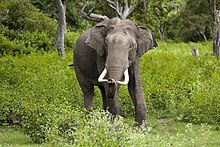| Wildlife of India |
|---|
 |
Biodiversity
|
| Protected areas |
Conservation
|
Organisations
|
Related topics
|
India is one of the most biodiverse regions and is home to a large variety of wildlife. It is one of the 17 megadiverse countries and includes three of the world's 36 biodiversity hotspots – the Western Ghats, the Eastern Himalayas, and the Indo-Burma hotspot.
About 24.6% of the total land area is covered by forests. It has various ecosystems ranging from the high altitude Himalayas, tropical evergreen forests along the Western Ghats, desert in the north-west, coastal plains and mangroves along the peninsular region. India lies within the Indomalayan realm and is home to about 7.6% of mammal, 14.7% of amphibian, 6% of bird, 6.2% of reptilian, and 6.2% of flowering plant species.
Human encroachment, deforestation and poaching are significant challenges that threaten the existence of certain fauna and flora. Government of India established a system of national parks and protected areas in 1935, which have been subsequently expanded to nearly 1022 protected areas by 2023. India has enacted the Wildlife Protection Act of 1972 and special projects such as Project Tiger, Project Elephant and Project Dolphin for protection of critical species.
Fauna
Main article: Fauna of India
India has an estimated 92,873 species of fauna, roughly about 7.5% of the species available worldwide. Insects form the major category with 63423 recorded species. India is home to 423 mammals, 1233 birds, 526 reptiles, 342 amphibians, 3022 fish apart from other species which form 7.6% of mammal, 14.7% of amphibian, 6% of bird, 6.2% of reptilian species worldwide. Among Indian species, only 12.6% of mammals and 4.5% of birds are endemic, contrasting with 45.8% of reptiles and 55.8% of amphibians.
The Indian subcontinent was formerly an island landmass (Insular India) that split away from Gondwana around 125 million years ago, during the Early Cretaceous. Late Cretaceous Insular Indian faunas were very similar to those found on Madagascar due to their shared connection until around 90 million years ago. The Cretaceous-Paleogene extinction event around 66 million years ago caused the extinction of many animals native to Insular India, such as its titanosaurian and abelisaurid dinosaurs. During the early Cenozoic era, around 55-50 million years ago, the Indian subcontinent collided with Laurasia, allowing animals from Asia to migrate into the Indian subcontinent. Some elements of India's modern fauna, such as the frog family Nasikabatrachidae and the caecillian family Chikilidae, are suggested to have been present in India prior to its collision with Asia.
Four species of megafauna (large animals) native to India became extinct during the Late Pleistocene around 10,000-50,000 years ago as part of a global wave of megafauna extinctions, these include the very large elephant Palaeoloxodon namadicus (possibly the largest land mammal to have ever lived), the elephant relative Stegodon, the hippopotamus Hexaprotodon, and the equine Equus namadicus. These extinctions are thought to have been after the arrival of modern humans on the Indian subcontinent. Ostriches were also formerly native to India, but also became extinct during the Late Pleistocene.
India is home to several well-known large animals, including the Indian elephant, Indian rhinoceros, and Gaur. India is the only country where the big cats tiger and lion exist in the wild. Members of the cat family include Bengal tiger, Asiatic lion, Indian leopard, snow leopard, and clouded leopard. Representative and endemic species include blackbuck, nilgai, bharal, barasingha, Nilgiri tahr, and Nilgiri langur.
There are about 31 species of aquatic mammals including dolphins, whales, porpoises, and dugong. Reptiles include the gharial, the only living members of Gavialis and saltwater crocodiles. Birds include peafowl, pheasants, geese, ducks, mynas, parakeets, pigeons, cranes, hornbills, and sunbirds. Endemic bird species include great Indian hornbill, great Indian bustard, nicobar pigeon, ruddy shelduck, Himalayan monal, and Himalayan quail.
Flora

About 24.6% of the total land area is covered by forests. It has various ecoregions ranging from the high altitude Himalayas, tropical evergreen forests along the Western Ghats, desert in the north-west, coastal plains and mangroves along the peninsular region. India's climate has become progessively drier since the late Miocene, reducing forest cover in northern India in favour of grassland.
There are about 29,015 species of plants including 17,926 species of flowering plants. This is about 9.1% of the total plant species identified worldwide and 6,842 species are endemic to India. Other plant species include 7,244 algae, 2,504 bryophytes, 1,267 pteridophytes and 74 gymnosperms. One-third of the fungal diversity of the world exists in India with over 27,000 recorded species, making it the largest biotic community after insects.
Conservation
Main article: Conservation in IndiaIndia harbors 172 (2.9%) IUCN-designated threatened species. These include 39 species of mammals, 72 species of birds, 17 species of reptiles, three species of amphibians, two species of fish, and a number of insects including butterflies, moths, and beetles.
Human encroachment, deforestation and poaching are significant challenges that threaten the existence of certain fauna and flora. Government of India established a system of national parks and protected areas in 1935, which have been subsequently expanded to nearly 1022 protected areas by 2023. Various laws have been enacted such as Indian Forest Act, 1927 and Wildlife Protection Act of 1972 and special projects such as Project Tiger, Project Elephant and Project Dolphin have been initiated for the protection of forests, wildlife and critical species.
As of 2023, there are 1022 protected areas including 106 national parks, 573 wildlife sanctuaries, 220 conservation reserves and 123 community reserves. In addition, there are 55 tiger reserves, 18 biosphere reserves and 32 elephant reserves.
National symbols
| Symbol | Name | Scientific name | Image | Reference |
|---|---|---|---|---|
| Animal | Tiger | Panthera tigris | 
|
|
| Bird | Indian peafowl | Pavo cristatus | 
|
|
| Flower | Lotus | Nelumbo nucifera | 
|
|
| Tree | Banyan | Ficus benghalensis | 
|
|
| Fruit | Mango | Mangifera indica | 
|
|
| Aquatic animal | Ganges river dolphin | Platanista gangetica | 
|
|
| Heritage animal | Indian elephant | Elephas maximus | 
|
|
| Reptile | King cobra | Ophiophagus hannah | 
|
See also
- List of birds of India
- List of mammals of India
- List of reptiles of South Asia
- Wildlife population of India
References
- Stephen, A.; Suresh, R. & Livingstone, C. (2015). "Indian Biodiversity: Past, Present and Future". International Journal of Environment and Natural Sciences. 7: 13–28.
- "Biodiversity Hotspots". CEPF. Retrieved 5 March 2017.
- ^ "List of Species". Government of India. Retrieved 1 December 2023.
- ^ "Fauna of India". Government of India. Retrieved 1 December 2023.
- ^ Biodiversity profile for India (Report). United Nations Environmental Programme (UNEP), World Conservation Monitoring Centre. Retrieved 1 December 2023.
- ^ Parmar, Varun; Prasad, G.V.R. (1 March 2020). "Vertebrate evolution on the Indian raft - Biogeographic conundrums". Episodes. 43 (1): 461–475. doi:10.18814/epiiugs/2020/020029. ISSN 0705-3797.
- Thomas John Dixon Halliday (15 February 2017). "Faunal similarity in Madagascan and South Indian Late Cretaceous vertebrate faunas". Palaeogeography, Palaeoclimatology, Palaeoecology. 468: 70-75. doi:10.1016/j.palaeo.2016.11.046.
- Chatterjee, Sankar (2020), Prasad, Guntupalli V.R.; Patnaik, Rajeev (eds.), "The Age of Dinosaurs in the Land of Gonds", Biological Consequences of Plate Tectonics, Vertebrate Paleobiology and Paleoanthropology, Cham: Springer International Publishing, pp. 181–226, doi:10.1007/978-3-030-49753-8_8, ISBN 978-3-030-49752-1, retrieved 12 August 2024
- Turvey, Samuel T.; Sathe, Vijay; Crees, Jennifer J.; Jukar, Advait M.; Chakraborty, Prateek; Lister, Adrian M. (January 2021). "Late Quaternary megafaunal extinctions in India: How much do we know?". Quaternary Science Reviews. 252: 106740. Bibcode:2021QSRv..25206740T. doi:10.1016/j.quascirev.2020.106740. S2CID 234265221.
- Jukar, A.M.; Lyons, S.K.; Wagner, P.J.; Uhen, M.D. (January 2021). "Late Quaternary extinctions in the Indian Subcontinent". Palaeogeography, Palaeoclimatology, Palaeoecology. 562: 110137. Bibcode:2021PPP...56210137J. doi:10.1016/j.palaeo.2020.110137. S2CID 228877664.
- Baskaran, N. & Desai, A. A. (1996). "Ranging behaviour of the Asian elephant (Elephas maximus) in the Nilgiri Biosphere Reserve, South India" (PDF). SSC Asian Elephant Specialist Group. 15: 41–57.
- Choudhury, A. U. (1985). "Distribution of Indian one-horned rhinoceros". Tiger Paper. 12 (2): 25–30.
- Jhala, Y. V.; Qureshi, Q.; Nayak, A. K. (2019). Status of Tigers, Co-Predators and Prey in India 2018. Summary Report. TR No./2019/05. New Delhi, Dehradun: National Tiger Conservation Authority & Wildlife Institute of India.
- Singh, H. S. & Gibson, L. (2011). "A conservation success story in the otherwise dire megafauna extinction crisis: The Asiatic lion (Panthera leo persica) of Gir forest" (PDF). Biological Conservation. 144 (5): 1753–1757. doi:10.1016/j.biocon.2011.02.009.
- Mondal, K.; Gupta, S.; Bhattacharjee, S.; Qureshi, Q. & K. Sankar (2012). "Prey selection, food habits and dietary overlap between leopard Panthera pardus (Mammalia: Carnivora) and re-introduced tiger Panthera tigris (Mammalia: Carnivora) in a semi-arid forest of Sariska Tiger Reserve, Western India". Italian Journal of Zoology. 79 (4): 607–616. doi:10.1080/11250003.2012.687402.
- Mishra, C. (1997). "Livestock depredation by large carnivores in the Indian trans-Himalaya: conflict perceptions and conservation prospects" (PDF). Environmental Conservation. 24 (4): 338–343. doi:10.1017/S0376892997000441.
- Choudhury, A. U. (1992). "The Clouded Leopard in Assam". Oryx. 27 (1): 51–53. doi:10.1017/s0030605300023966.
- Aquatic mammals of India (PDF) (Report). Marine Biology Regional Centre, Zoological Survey of India. 2011. Retrieved 1 December 2023.
- "7 Rare and Exotic Wildlife Species that can be found in India". 19 June 2015.
- "Animals in Indian Sub-Continent". Archived from the original on 2 March 2022.
- ^ "Protected areas". Government of India. Retrieved 1 December 2023.
- "Eco-regions of India". Ecoregion restoration alliance. Retrieved 1 December 2023.
- Polissar, Pratigya J.; Uno, Kevin T.; Phelps, Samuel R.; Karp, Allison T.; Freeman, Katherine H.; Pensky, Jennifer L. (April 2021). "Hydrologic Changes Drove the Late Miocene Expansion of C 4 Grasslands on the Northern Indian Subcontinent". Paleoceanography and Paleoclimatology. 36 (4). doi:10.1029/2020PA004108. ISSN 2572-4517.
- Manoharachary, C.; Sridhar, K.; Singh, R.; Adholeya, A.; Suryanarayanan, T. S.; Rawat, S. & Johri, B.N. (2005). "Fungal biodiversity: Distribution, conservation and prospecting of fungi from India" (PDF). Current Science. 89 (1). Archived from the original (PDF) on 28 August 2017.
- Fungal biodiversity: Distribution, conservation and prospecting of fungi from India (Report). Retrieved 1 December 2023.
- Groombridge, B. (1993). The 1994 IUCN Red List of Threatened Animals (Report). IUCN. p. 286.
- "India's bird populations 'declining sharply', research shows". Independent.co.uk. 18 February 2020. Retrieved 1 December 2023.
- Tritsch, M.E. (2001). Wildlife of India. London: Harper Collins. ISBN 0-00-711062-6.
- Singh, M. P.; Singh, J. K.; Mohanka, R. (2007). Forest Environment and Biodiversity. Daya Publishing House. pp. 116–118. ISBN 9788170354215.
- ^ "National symbols". Government of India. Retrieved 1 December 2023.
- ^ "National symbols of India". Government of India. Retrieved 1 December 2023.
- "Dolphin becomes India's national aquatic animal". Hindustan Times. Archived from the original on 8 October 2009.
- ^ "Significant symbols". The Hindu. 8 August 2011. Retrieved 1 December 2023.
Further reading
- Saravanan, Velayutham. Environmental History of Modern India: Land, Population, Technology and Development (Bloomsbury Publishing India, 2022) online review
- Prasad, S.N.; Ramachanandra, T.V.; Ahalya, N.; Sengupta, T.; Kumar, A.; Tiwari, A.K.; Vijayan, V.S. & Vijayan, L. (2002). "Conservation of wetlands of India – a review". Tropical Ecology. 43 (1): 173–186. CiteSeerX 10.1.1.526.3559.
- Manoharachary, C.; Sridhar, K.; Singh, R.; Adholeya, A.; Suryanarayanan, T. S.; Rawat, S. & Johri, B.N. (2005). "Fungal biodiversity: Distribution, conservation and prospecting of fungi from India" (PDF). Current Science. 89 (1). Archived from the original (PDF) on 28 August 2017.
- Jamaluddin, M.G.; Goswami; B.M. Ojha (2004). Fungi of India 1989–2001. Scientific Publishers. ISBN 8172333544.
External links
- Official website of: Government of India, Ministry of Environment & Forests
- "Legislations on Environment, Forests, and Wildlife" from the Official website of: Government of India, Ministry of Environment & Forests
- "India's Forest Conservation Legislation: Acts, Rules, Guidelines", from the official website of the Government of India, Ministry of Environment & Forests
- Wildlife Legislations, including - "The Indian Wildlife (Protection) Act" from the Official website of: Government of India, Ministry of Environment & Forests
| Geography of India | |
|---|---|
| Geology | |
| Culture | |
| Landforms | |
| Regions | |
| Geographical regions | |
| Subdivisions | |
| Ecology | |